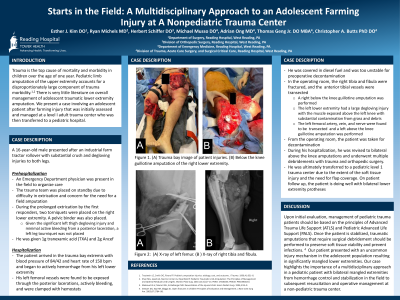Trauma
Category: Quickshot Oral Session 05
Quickshot Oral : Quickshot Oral Session 05
STARTS IN THE FIELD: A MULTIDISCIPLINARY APPROACH TO AN ADOLESCENT FARMING INJURY AT A NONPEDIATRIC TRAUMA CENTER
Saturday, February 11, 2023
3:00pm - 4:00pm East Coast USA Time

- EK
Esther Kim, DO
Reading Hospital, United States
- CB
Christopher A. Butts, PhD, DO
Trauma/Acute Care Surgeon
Reading Hospital, United States
Presenter(s)
Principal Contact(s)
Objectives: Trauma is the top cause of mortality and morbidity in children over the age of one year. Pediatric limb amputation accounts for a disproportionately large component of trauma morbidity. There is very little literature on overall management of pediatric traumatic amputation, specifically of the lower extremity. We present a case involving a pediatric patient that was initially assessed and managed at a level I adult trauma center who was then transferred to a pediatric hospital.
Case Description: A 17-year-old male presented after a farm tractor rollover with substantial crush and degloving injuries to the bilateral lower extremities. The trauma field team was placed on standby due to difficulty in extrication and concern for need for field amputation, while an emergency department physician went into the field to organize care. During the prolonged extrication by first responders, the patient initially required torniquets of the right lower extremity and a pelvic binder was placed in the field. He was also given transexamic acid (TXA) and antibiotics. The patient arrived in extremis, had his left femoral vessels clamped in the trauma bay, was covered in diesel fuel and was too unstable for preoperative decontamination. Mass transfusion protocol was imitated, and the patient was taken to the operating room for bilateral lower extremity guillotine amputations. He was then taken to decontamination and transferred to the surgical intensive care unit for further resuscitation. During his hospitalization, he was revised to bilateral above the knee amputations. He required multiple debridements due to necrotic tissue present in the wounds. He was ultimately transferred to a pediatric trauma center due to the extent of the soft tissue injury and need for flap coverage.
Discussion: Our case highlights the importance of a multidisciplinary approach in all aspects of the patient’s care; prehospital, intrahospital, and post hospital care. Our patient presented with an uncommon injury mechanism in the adolescent population resulting in significantly mangled lower extremities. This adolescent patient was managed at an adult level 1 trauma center only requiring transfer for subspecialized care once flap coverage was required.
Methods:
Results:
Conclusion:
Case Description: A 17-year-old male presented after a farm tractor rollover with substantial crush and degloving injuries to the bilateral lower extremities. The trauma field team was placed on standby due to difficulty in extrication and concern for need for field amputation, while an emergency department physician went into the field to organize care. During the prolonged extrication by first responders, the patient initially required torniquets of the right lower extremity and a pelvic binder was placed in the field. He was also given transexamic acid (TXA) and antibiotics. The patient arrived in extremis, had his left femoral vessels clamped in the trauma bay, was covered in diesel fuel and was too unstable for preoperative decontamination. Mass transfusion protocol was imitated, and the patient was taken to the operating room for bilateral lower extremity guillotine amputations. He was then taken to decontamination and transferred to the surgical intensive care unit for further resuscitation. During his hospitalization, he was revised to bilateral above the knee amputations. He required multiple debridements due to necrotic tissue present in the wounds. He was ultimately transferred to a pediatric trauma center due to the extent of the soft tissue injury and need for flap coverage.
Discussion: Our case highlights the importance of a multidisciplinary approach in all aspects of the patient’s care; prehospital, intrahospital, and post hospital care. Our patient presented with an uncommon injury mechanism in the adolescent population resulting in significantly mangled lower extremities. This adolescent patient was managed at an adult level 1 trauma center only requiring transfer for subspecialized care once flap coverage was required.
Methods:
Results:
Conclusion:

